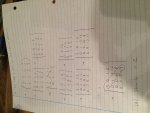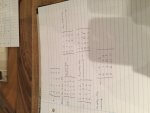Hi all, I was hoping somebody could help me find the determinantof a 4 x 4 matrix.
I tried to make the numbers below the main diagonal all 0’sso the determinant is just the product of the main diagonal. However my answeris way off.
On a side note (if I can ever get this method to work), canyou do e.g. 2R1 + 3R2 or can you only multiply one row by a scalar?
Thanks in advance.

I tried to make the numbers below the main diagonal all 0’sso the determinant is just the product of the main diagonal. However my answeris way off.
On a side note (if I can ever get this method to work), canyou do e.g. 2R1 + 3R2 or can you only multiply one row by a scalar?
Thanks in advance.


